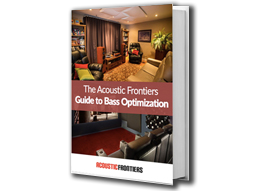Acoustic Frontiers has the expertise to help you select the best projection screen for your home theater.
Request A QuoteThe function of a home theater projection screen is quite simple - it displays the image from a projector. The projector can be mounted behind the screen - rear projection - or in front of it - front projection. Rear projection is rare but can be helpful in situations with high ambient light.
Most screens are fixed; they have a frame - usually a velvet wrapped aluminum extrusion - supporting a tensioned piece of screen material. Another common screen type is the motorized retractable, where the material extends and retracts from a wall or ceiling-mounted screen casing.
Screen materials come in many varieties, from plain white vinyl to woven acoustically transparent fabrics to ambient light rejecting (ALR) materials using optical coatings. White materials are typically used in dedicated rooms with complete control over light from windows, whereas ALR materials are often utilized in living spaces functioning as media rooms. Our favored materials are acoustically transparent (AT) and allow the center speaker to be placed behind the screen as it is in a commercial theater.
Seymour AV's Precision frame is our go-to front projection screen for home theaters on a tight budget.The Precision frame features high-performance Baritone velvet and is available with our preferred XD screen material. The XD is a woven vinyl material that couples acoustical transparency to relatively high gain and color neutrality. Its only downside is a 10' minimum seating distance. A frequently used screen is the F130 - their 130" wide / 2.35:1 aspect ratio model. Magnetic image masking panels, a product not widely offered by manufacturers, can be manually added or removed from the frame, to mask the image down to 16:9.
For reference class home theaters, a four-way masking screen is the way to go. The Director’s Choice is a native 2.0 aspect ratio that can mask virtually all aspect ratios in existence, such as 1.37:1 for the Wizard of Oz or 2.77:1 for Quentin Tarantino’s The Hateful Eight. Stewart offers a range of reference class projection materials to go with this screen, including the Microperf X2 acoustically transparent StudioTek 100 and 130 G4. All this performance isn’t inexpensive, but if you want the best, this is it!



With Acoustic Frontiers, all it takes is 4 simple steps.
We'll take the time to understand your unique needs and goals to customize our approach to designing the best experience for you.
This is where the magic happens and what really makes Acoustic Frontiers stand out. Every room is different, and we’ll account for all the elements that impact performance in your space to ensure you get the best system for your budget.
We’ll make the installation process as painless as possible and carefully calibrate your system to optimize performance.
You deserve the best, and now you’ve got it. Put on your favorite movie or album, or create your next track because the system you wanted is yours to enjoy.
This guide teaches you everything you need to know to get the
best bass possible from your system.

“Acoustic Frontiers were very patient and helpful when it came to selecting speakers and equipment for the room. As a vendor for a multitude of companies, I really felt that I was getting objective advice. They helped me select everything from the speakers, AVR, to even the projector and screen! The end result was nothing short of amazing and my family and I couldn’t be more thrilled. Acoustic Frontiers receives my highest recommendation. We can’t thank you all enough!”
“One of Acoustic Frontiers’ strengths was their willingness to work flexibly with us from both a budget and design perspective. Although they are of course well prepared to make equipment suggestions, they are also willing to work with whatever equipment is already in place to create the best system possible. We ended up with a mix of gear, but it all works together seamlessly. Post-installation and calibration, the system looks and sounds phenomenal!”
“Acoustic Frontiers started out with a design review (since the room work had already begun) and after a couple of interactions I was comfortable enough to let them plan/guide the rest of the build, and purchase the AV equipment from them. They took the time to understand our requirements, discuss equipment options and budget considerations, and were able to provide recommendations without any over-selling. The room has turned out beyond our expectations, and it would not have been possible without Acoustic Frontiers’ home theater products & services.”

Nyal Mellor, Founder, Acoustic Frontiers